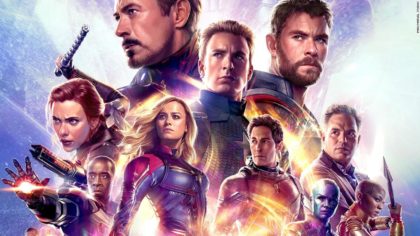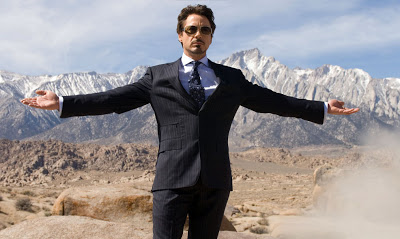
This post contains spoilers for Avengers: Endgame; it is difficult to discuss the film’s themes in any depth without spoiling at least some elements.
For all the secrecy surrounding Avengers: Endgame, many of the film’s best moments feel inevitable, the fulfillment of promises made in earlier installments. So I especially enjoyed the genuine surprise of seeing the word “Five” appear on the screen, then a very knowing pause, then “Years Later.” The film initially meets expectations by picking up right where Avengers: Infinity War left off: half of all living beings turned to dust. But a futile act of lashing out from our heroes is quickly followed by the revelation that they have been living with their failures for half a decade. By all indications, the remaining 50% of the population is understandably still unable to fully return to life as usual.
Long passages of time can be challenging to communicate cinematically, but I reacted viscerally to those three words. Living a year of real time with the ending of Infinity War may have helped provide a sense of weight. And for another 30 minutes or so, we simply watched our heroes process their grief. Even with a positive resolution surely forthcoming, we were given space to consider some hopeless possibilities. And whatever the outcome, significant consequences were already a reality.
Seeing Captain America, Black Widow and the others still grieving, still at a loss all those years later reminded me that time does not heal all wounds, at least not passively. And in their own four-color fashion, these superhero films continue to reflect our own post-9/11 wounds. The story continued in Avengers: Endgame began in Afghanistan as fictional weapons manufacturer Tony Stark visited American soldiers fighting an all-too-real war in the opening to 2008’s Iron Man. Four years later, the first Avengers movie ended with an unanticipated attack on New York. In many ways, Tony and the Marvel Universe have spent the subsequent films dramatically overreacting. The prolonged and ongoing response and recovery reflects our own still-healing wounds from 2001 and countless other personal and public tragedies.
Confronted with an IED and then an alien invasion, Tony loses confidence in what he trusts most–Tony Stark–and walls himself off in a suit of armor. He imagines doing the same for the entire world. When Black Panther appears several films later and announces to the UN that “in times of crisis the wise build bridges, while the foolish build barriers,” which does he imagine Iron Man to be? How about Captain America, who has lost his confidence in authority thanks to the government conspiracy of Captain America: The Winter Soldier? By the time the two men meet Black Panther, the bridges between them are smoldering, as seen in Captain America: Civil War. From there, tragedy reproduces after its kind; Thanos steps into the silence between them and rends the universe in two.

We left Avengers: Infinity War with a broken world, and after that “Five Years Later” it remains broken. If time did not heal all wounds, can the Time Stone? While there are time travel shenanigans, the storytellers wisely eschew the easy option of a grand reset. Instead, what heals all wounds is healing. First, there is pain, signifying where continuity has been disrupted and what was protected is now exposed. Then, a series of chemical messages: “Help!” “Come quick!” The call is answered, and cells reach out, coordinating to replace what was lost and restore the whole. Healing is work, communal work, communicative work.
And so the path to restoring, not rewinding, the Marvel Cinematic Universe begins with a conversation. After nearly a decade of silence, a dialogue opens up between Iron Man and Captain America. Sure, this is a blockbuster; we will also get a liberal dose of fists and lasers before all is said and done. Still, some things must be said before anything is done. In those conversations, the team speaks into existence solutions to problems that can’t be solved by hitting them harder. Knowledge is shared; relationships are rebuilt. And then, y’know: punching.
Punching is more of Thor’s department, but even he needs to talk through some healing, with his mother Frigga. Blockbusters don’t often have a lot of time for mothers, and up to this point Frigga’s most notable contribution was a brief fight that ended in her death. Nevertheless, Thor turns to her for help processing his own failure. “Everyone fails at who they are supposed to be,” she tells him. “The measure of a person, a hero, is how they succeed at being who they are.”
For a corner of cinema associated with aspirations of muscles and moral certitude, that’s a surprisingly human message. We all fail to meet expectations, indeed the sum total of everyone’s expectations for us may be mutually exclusive. And so I don’t thing Frigga was trying to free Thor from trying; I think she was freeing him from trying the impossible. What remained was still improbable. But an improbable task can be accomplished in time. We just have to pick up our hammers and get to work.
Since this post is attracting some new readers: If you are interested in nerdy pop culture, Christian faith, and science, consider checking out Faith across the Multiverse.
Andy has worn many hats in his life. He knows this is a dreadfully clichéd notion, but since it is also literally true he uses it anyway. Among his current metaphorical hats: husband of one wife, father of two teenagers, reader of science fiction and science fact, enthusiast of contemporary symphonic music, and chief science officer. Previous metaphorical hats include: comp bio postdoc, molecular biology grad student, InterVarsity chapter president (that one came with a literal hat), music store clerk, house painter, and mosquito trapper. Among his more unique literal hats: British bobby, captain’s hats (of varying levels of authenticity) of several specific vessels, a deerstalker from 221B Baker St, and a railroad engineer’s cap. His monthly Science in Review is drawn from his weekly Science Corner posts — Wednesdays, 8am (Eastern) on the Emerging Scholars Network Blog. His book Faith across the Multiverse is available from Hendrickson.

Leave a Reply